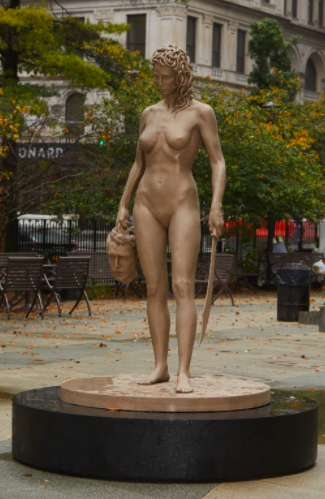Medusa’s origin story is varied. Yet, the most widely recognized comes from Ovid’s Metamorphosis, in which Medusa was a mortal maiden in the temple of Athena, where she was raped by Poseidon. Soon after, Athena banished and cursed Medusa with a head of snakes and a gaze that turned men to stone. As the story goes, she was eventually beheaded by the epic hero Perseus, who used her head as a weapon before gifting it to Athena. Yesterday in New York City, a seven-foot-tall sculpture of Medusa was unveiled across from the Manhattan Supreme Court, where men accused of sexual assault, including Harvey Weinstein, have stood trial. However, this artistic rendition is an inverse of the Greek myth surrounding Medusa. The statue does not show Perseus holding the head of Medusa, but the other way around.
The exhibition was conceived by MWTH (Medusa With The Head), an artist-led project that reimagines classical artists and their work. The sculpture was created in 2008 by Argentine-Italian artist Luciano Garbati but has amassed newfound fame in recent years. After Garbati posted a picture of his statue on social media in 2018, it went viral. Bek Andersen, the founder of MWTH, explained over email, “In my own art practice I have investigated flipping the script of power and gender roles, and in that moment, Garbati’s unapologetically revisionist Medusa spoke to my interests by reimagining the outcome of the myth of Medusa.”
Placed across from the storied courthouse, Garbati says that Medusa’s location is important because the statue explores themes of justice. Yet, questions have been raised about why, then, would Medusa not hold the head of her rapist. Andersen explains that her initial inspiration for the project was sparked by a more specific event in recent history, the Kavanaugh hearings. “A man abuses his power… gets called out on it, and the woman is the one who ultimately suffers the fallout. And the man goes on to (gain) fame and acclaim,” she explains. Soon after, Andersen wrote a patron of the arts and proposed to bring the sculpture to New York and organize an exhibition featuring works that focus the center of power away from the patriarchal structures.
Andersen points out that Medusa is familiar enough to engage a broad population in the dialogue, but with popularity comes criticism, this time about the nudity of the sculpture. Medusa With The Head of Perseus, which was sculpted by a man, is thin, pube-less, and perky-breasted raising criticisms that the work is yet another iteration of the male gaze. “But really she’s still the total object of the male gaze here,” explains Jerry Saltz for New York Magazine, “not of thought, fear, admiration, pathos, power, agency, or anything other than male idiocy.” Saltz goes on to say that this sculpture is business as usual: another naked female figure made by another white male artist. In all fairness, on Medusa’s behalf, Jerry Saltz is also a white male. “The criticism directed at Medusa comes as no surprise,” says Andersen, “whether or not intended, the style of mannerist sculpture is provocative in the context of our western puritanical value system. For a woman to be nude, to be beautiful, for no one’s gain, she is no person’s property.” Andersen explains that this reimagined Medusa is an independent agent, acting in self-defense.
Feminist theorists (see: Hélène Cixous) argue that men’s retelling of Medusa narrative is driven by fear of women’s agency. This sculpture just doesn’t do anything to challenge that. If anything, it reinforces a false #MeToo narrative about rage/revenge —vs. power/justice.
— Anne Connell (@AnneMartinConn) October 10, 2020
Although controversial, the discussion surrounding the sculpture which depicts one of the most famous mythological characters of all time is neither unfounded nor surprising. In 2017 as the #MeToo movement took off, the media’s spotlight was mostly focused on A-list celebrity accusations despite the original call to action being created by a Black female activist, Tarana Burke, in 2006. “The women of color, trans women, queer people—our stories get pushed aside, and our pain is never prioritized,” said Burke for Time Magazine. “We don’t talk about indigenous women. Their stories go untold.” However, Andersen doesn’t see MWTH’s new exhibition as an ending point. Instead, “a movement forward in a long and imperfect journey toward an embodied cultural understanding of equality.”
Despite it all, Andersen welcomes criticism. She explains, “It is exciting that images of the work have generated a dynamic conversation. I don’t take issue with anyone’s response, and I don’t think any reaction could be considered wrong.” She continues to say that this sculpture is a reaction to an antiquated ideology. “My goal with MWTH project,” Andersen says, “is to provoke conversation and action that examines the narratives that shape our worldview.”
Medusa’s rebirth as a victor makes a statement, especially as it sits across from the place where many abusers during the #MeToo movement faced the court, but may we not forget about the women who aren’t famous, and don’t have cultural influence whose stories have not been told and whose abusers have not been held accountable.
Top Image: Luciano Garbati Medusa With The Head of Perseus, 2008-2020 Installed at Collect Pond Park. Courtesy of MWTH Project.
More from BUST:
Anita Hill Is Continuing To Fight For Survivors
Watch 100 Women Protest At Harvey Weinstein Rape Trial
Murder Of Mexican Feminist Sparks Outrage, Reflects Deeper Issue In The Nation


